
Wilcox County is a county of the U.S. state of Alabama. As of the 2020 census, the population was 10,600. Its county seat is Camden.

Tuskegee University is a private, historically black land-grant university in Tuskegee, Alabama. It was founded on Independence Day in 1881 by the Alabama Legislature.
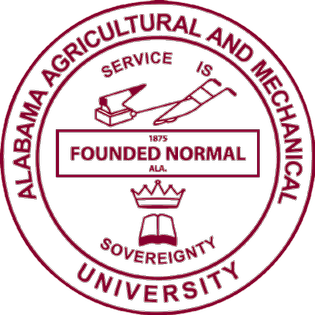
Alabama Agricultural and Mechanical University is a public historically black land-grant university in Normal, Huntsville, Alabama. Founded in 1875, it took its present name in 1969. It was one of about 180 "normal schools" founded by state governments in the 19th century to train teachers for the rapidly growing public common schools. It was one of 23 established to train African Americans to teach in segregated schools. Some closed but most steadily expanded their role and became state colleges in the early 20th century and state universities in the late 20th century. AAMU is a member-school of the Thurgood Marshall College Fund and is accredited by the Southern Association of Colleges and Schools. Alabama Agricultural and Mechanical University Historic District, also known as Normal Hill College Historic District, has 28 buildings and four structures listed in the United States National Register of Historic Places.

Grambling State University is a public historically black university in Grambling, Louisiana. Grambling State is home of the Eddie G. Robinson Museum and is listed on the Louisiana African American Heritage Trail. Grambling State is a member-school of the University of Louisiana System and Thurgood Marshall College Fund.

Central State University (CSU) is a public, historically black land-grant university in Wilberforce, Ohio, United States. It is a member-school of the Thurgood Marshall College Fund.
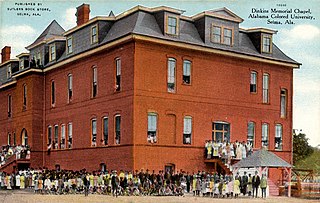
Selma University is a private historically black Baptist Bible college in Selma, Alabama, U.S.. It is affiliated with the Alabama State Missionary Baptist Convention.

Miles College is a private historically black college in Fairfield, Alabama. Founded in 1898, it is associated with the Christian Methodist Episcopal Church and a member of the United Negro College Fund.

Tougaloo College is a private historically black college in the Tougaloo area of Jackson, Mississippi, United States. It is affiliated with the United Church of Christ and Christian Church. It was originally established in 1869 by New York–based Christian missionaries for the education of freed slaves and their offspring. From 1871 until 1892 the college served as a teachers' training school funded by the state of Mississippi. In 1998, the buildings of the old campus were added to the National Register of Historic Places. Tougaloo College has a rich history of civic and social activism, including the Tougaloo Nine.

The Lincoln Normal School (1867–1970), originally Lincoln School and later reorganized as State Normal School and University for the Education of Colored Teachers and Students, was a historic African American school expanded to include a normal school in Marion, Alabama. Founded less than two years after the end of the Civil War, it is one of the oldest HBCUs in the United States.
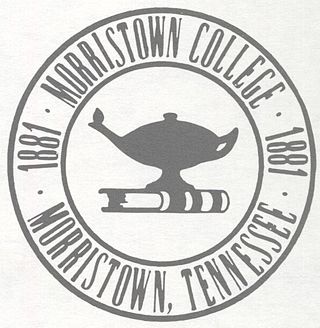
Morristown College was an African American higher education institution located in Morristown, the seat of Hamblen County, Tennessee. It was founded in 1881 by the national Freedman's Aid Society of the Methodist Episcopal Church. The school was renamed Knoxville College-Morristown Campus in 1989 and closed in 1994. Prior to the civil rights movement, the college held the distinction of being one of only two institutions in East Tennessee for African Americans, the other being Knoxville College, founded in 1875.
This is an incomplete list of historic properties and districts at United States colleges and universities that are listed on the National Register of Historic Places (NRHP). This includes National Historic Landmarks (NHLs) and other National Register of Historic Places listings. It includes listings at current and former educational institutions.
William Augustus Edwards, also known as William A. Edwards was an Atlanta-based American architect renowned for the educational buildings, courthouses and other public and private buildings that he designed in Florida, Georgia and his native South Carolina. More than 25 of his works have been listed on the National Register of Historic Places.

Laurinburg Institute is a historic African American preparatory school in Laurinburg, North Carolina. The school was founded in 1904 by Emmanuel Monty and Tinny McDuffie at the request of Booker T. Washington. Emmanuel McDuffie was a graduate from Snow Hill Normal and Industrial Institute.
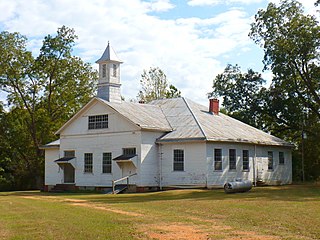
Prairie Mission, also known as the Prairie Mission School and Prairie Institute, was a historic African American school in the community of Prairie, Alabama. The school is the only survivor of the six original Presbyterian mission schools that once operated in Wilcox County. It was placed on the Alabama Register of Landmarks and Heritage on July 22, 1991 and subsequently on the National Register of Historic Places on October 29, 2001, due its significance to African American history.

The Wilcox Female Institute is a historic Greek Revival-style school building in Camden, Alabama. The two-story brick structure was built between 1845 and 1850 as a boarding school for girls. The school closed in 1910 and the building was then used by the Wilcox County school system for over 50 years. It was acquired by the Wilcox Historical Society in 1976. The group made it into their official headquarters. It was placed on the National Register of Historic Places on April 3, 1975.
Snow Hill is an unincorporated community in Wilcox County, Alabama, United States. Snow Hill has one site included on the National Register of Historic Places, the Snow Hill Normal and Industrial Institute.

Mississippi Industrial College was a historically black college in Holly Springs, Mississippi. It was founded in 1905 by the Mississippi Conference of the Colored Methodist Episcopal Church. After desegregation of community colleges in the mid-20th century, it had trouble competing and eventually closed in 1982. The campus was listed as a historic site on the National Register of Historic Places in 1980 and was acquired by Rust College in 2008.

The Street Manual Training School was a historic African American school in Richmond, Dallas County, Alabama. The campus comprised over 200 acres (81 ha), but most of it was sold after the school closed in 1971. The remaining 23.1-acre (9.3 ha) campus contains seven buildings constructed between 1906 and 1964 as well as a circa 1943 water tower. The school was listed on the National Register of Historic Places on July 28, 1999.

Consuela Lee Moorehead was an American jazz pianist, composer, arranger, music theory professor, and the founder of the Springtree/Snow Hill Institute for the Performing Arts. She fought to establish an arts school in rural Alabama, Moribund Academy. She is sometimes known as Consuela Lee or Consuela Lee Morehead.
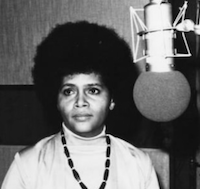
A. Grace Lee Mims was an African-American singer, radio personality and leading member of the arts community in Cleveland, Ohio best known for her 43 years as a radio host and producer on the classical radio station WCLV.



















